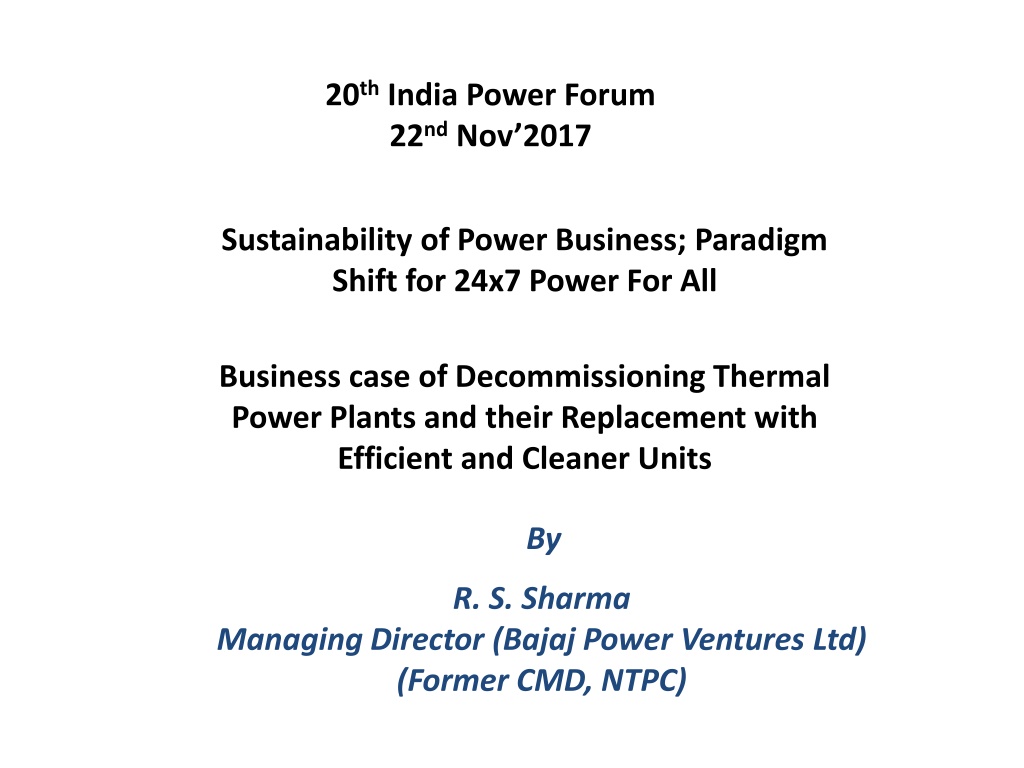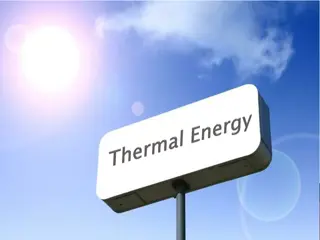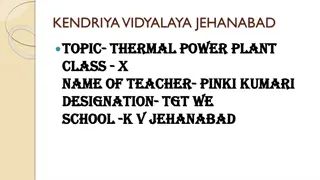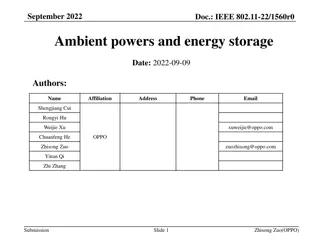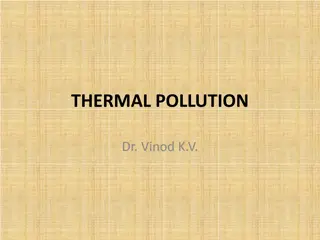Discussion on Sustainable Energy Solutions and Efficiency Improvements in Thermal Power Plants
The 20th India Power Forum held on 22nd November 2017 highlighted the importance of sustainability in the power business, focusing on the paradigm shift towards 24x7 power for all. Topics included decommissioning thermal power plants for more efficient and cleaner units, with insights from industry experts like R. S. Sharma. The event also covered the installed capacity of different power sectors, details of coal-based thermal power capacities, heat rate comparisons, and thermal efficiency improvements strategies.
- Sustainable Energy Solutions
- Thermal Power Plants
- Efficiency Improvements
- India Power Forum
- Energy Sector
Download Presentation

Please find below an Image/Link to download the presentation.
The content on the website is provided AS IS for your information and personal use only. It may not be sold, licensed, or shared on other websites without obtaining consent from the author. Download presentation by click this link. If you encounter any issues during the download, it is possible that the publisher has removed the file from their server.
E N D
Presentation Transcript
20th India Power Forum 22ndNov 2017 Sustainability of Power Business; Paradigm Shift for 24x7 Power For All Business case of Decommissioning Thermal Power Plants and their Replacement with Efficient and Cleaner Units By R. S. Sharma Managing Director (Bajaj Power Ventures Ltd) (Former CMD, NTPC)
Installed capacity of country as on 31stOct2017 Sr. No. Sector Capacity in MW % age Share 1 Total Thermal 219414.51 66.26% Coal 193426.50 58.41% Gas 25150.38 7.60% Oil 837.63 0.25% 2 Hydro (Renewable) 44765.42 13.52% 3 Nuclear 6780.00 2.05% 60157.66 18.17% 4 RES** (MNRE) Total 331117.58 100%
Details of coal based thermal power capacities Range No of Units MW % Upto 110 MW >110 MW & <200 MW 200/ 210/ 250/270MW >270 MW & <490 MW 107 8241.5 4.3 61 8252 4.3 228 50680 26.3 42 12900 6.7 490 MW to 800 MW 193 112300 58.4 631 192373.5* 100 Total * The figures are based on Aug 2017 data
Existing design heat rate Vs normative heat rate comparison Range Present Design Turbine Heat rate K Cal/ KWH Operating GSHR with 4.5% margin (boiler eff 86%) Normative GSHR K Cal/ KWH Difference in K Cal/ KWH Operating thermal eff % Upto 60 MW 2309 2900 95 29.65 2805 110 MW 200/ 210/250 MW 500/600 MW Sub Critical 660 MW Super critical 800 MW Super Critical 2175 2750 107 31.3 2643 1960-1980 2450-2500 44 68 34.4 2382 2406 1940-1950 2357 2369 2375-2425 6 18 35.5 1830-1860 2224 2260 2258 0 - 34 38.1 2086 2148 Boiler eff 89%---- 1777 -1829 >40
Latest available design heat rate Vs normative heat rate comparison Latest Design Turbine Heat rate K Cal/ KWH Operating GSHR with 4.5% margin (boiler eff 86%) Normative GSHR K Cal/ KWH Difference in K Cal/ KWH Operating Thermal efficiency % Range 110 MW 1960 2750 368 36.1 2382 200/ 210/250 MW 2278 1875 2450 172 37.7 500/600 MW Sub Critical 1860 2260 2375 115 38.1 660 MW Super critical 1818 2209 2258 49 38.9 Ultra Super critical 2066 Boiler eff. 89% 1760 ----
Margin of Improvement of thermal efficiency Range Operating GSHR with 4.5% margin (boiler eff 86%) Latest calculated GSHR with 4.5% margin (boiler eff 86%) Scope of Improvement K Cal/KWH Scope of improvement in thermal efficiency % 3.6 110 MW 261 2643 2382 200/ 210/250 MW 2.0 128 2382 2406 2278 500/600 MW Sub Critical 1.8 2357 2369 2260 109 660 MW Super critical 0.9 2224 2260 2209 51
Comparison of coal based thermal efficiency Note: From 2012 to 2014 the average efficiency has improved to above 30% Ref: Ecofys report-2014.
Potential of improvements in plant efficiency in APEC countries Category Area of improvement Net efficiency gain (% points) Pulveriser and feeder upgrades 0.30 Combustion system Air heater repair or upgrade 0.25 Soot blower improvements 0.35 Excess air I&C 0.20 Feed water heater repairs 0.40 Steam cycle Heat transfer tube upgrades 0.60 Steam turbine blades, sealings 0.50 Cycle isolation 0.50 Condenser repairs 0.40 O&M training O&M Computerized maintenance and management systems and reliability centred maintenance. Included in combustion and steam cycle gains. Efficient operation realised over the long term. Distributed control systems Combined total 3.50 Ref: (Boncimino and others, 2005) IEA , Nov 2015
Decommissioning Vs efficiency improvement in existing capacities
Case-1: With super critical parameters and unit size 660 MW (replacement of 3 units of 200/210 MW) Description UOM Present New Percentage improvement THR kcal/kWh 2050 1818 11.32 Boiler efficiency % 85 86 1.17 GSHR kcal/kWh 2520 2209 12.35 Aux Power Consump % 9 6.75 25 NSHR kcal/kWh 2770 2369 14.46 Comparison of cost of generation Description UOM Present New Difference FC Rs 0.66 2.30 (1.64) VC Rs 2.25 1.92 0.33 Total Cost Rs 2.91 4.22 (1.31) Note: The cost of generation will substantially increase. If unit runs in subcritical parameters, the generation cost shall further increase.
Case-2: Expected benefits by improving a 210 MW unit Description UOM Pre R&M After R&M (target) Percentage improvement THR kcal/kWh 2050 1875 8.54 Boiler efficiency % 85 86 1.17 GSHR kcal/kWh 2520 2278 9.60 Aux Power Consump % 9 8.5 5.55 NSHR kcal/kWh 2770 2490 10.09 Presently efficient turbines are available with 1875 THR without change in boiler s steam parameters. This results in reduction of Net SHR by by about 280 counts. Cost of generation Description UOM Present New Difference FC Rs 0.66 0.93 (0.27) VC Rs 2.25 2.02 0.23 Total Cost Rs 2.91 2.95 (0.04) The renovation cost per MW with turbine R&M taken as Rs 1 Crore/MW. With this the total cost of generation is expected to rise by Rs 0.04/KWH
CO2 emission Vs efficiency 900 CO2 emission (gms/KWH) 850 800 750 700 650 600 25 30 35 40 45 Thermal Efficiency (%)
Actionable points for improving thermal efficiency of plant 1. HP, IP and LP turbine retrofits, using modern 3-D blading, new control valves. 2. Installation of new control systems (need changing every 10 years). 3. New burner management systems. 4. Air Pre Heater improvements (sealing, additional sectors). 5. Upgrading of mills to reach rated/ increase capacity. 6. ESP improvements to reduce energy use and improved collection efficiency. 7. High pressure feed water heater s improvements. 8. Condenser improvements.
Conclusion Selective decommissioning is OK. Non reheat design units those have completed useful life be decommissioned. No decommissioning of 200 MW sets unless the same is non reheat with lower main steam parameters. 26% of installed capacity (50680 MW) consists of 200/210/250/270 MW. More than 50% of these are older units which are operating at higher heat rate. For efficiency improvement 200 MW sets stand to be major candidates and target THR should be 1875. For fixing of bottom line of thermal efficiency parameters of units a national level debate may be organized on achievable thermal efficiency of coal based plant based on national/ international data benchmarking. National average plant efficiency to be targeted above 37% from present level of 32-33% Continue. . . .
No capacity addition in place of decommissioned capacities requires to be undertaken. Rather efforts to be primarily focused on increasing the PLF from existing 60% to 80%/ 85%. This, by itself, will marginally improve the operating efficiency of thermal power plants and also unleash enough more MWs within current installed capacity to offset any demand of fresh capacity addition for at least next 5 yrs. Any new capacity addition in future be considered only within 100 kms distance of pit head/ costal locations. ------------------
